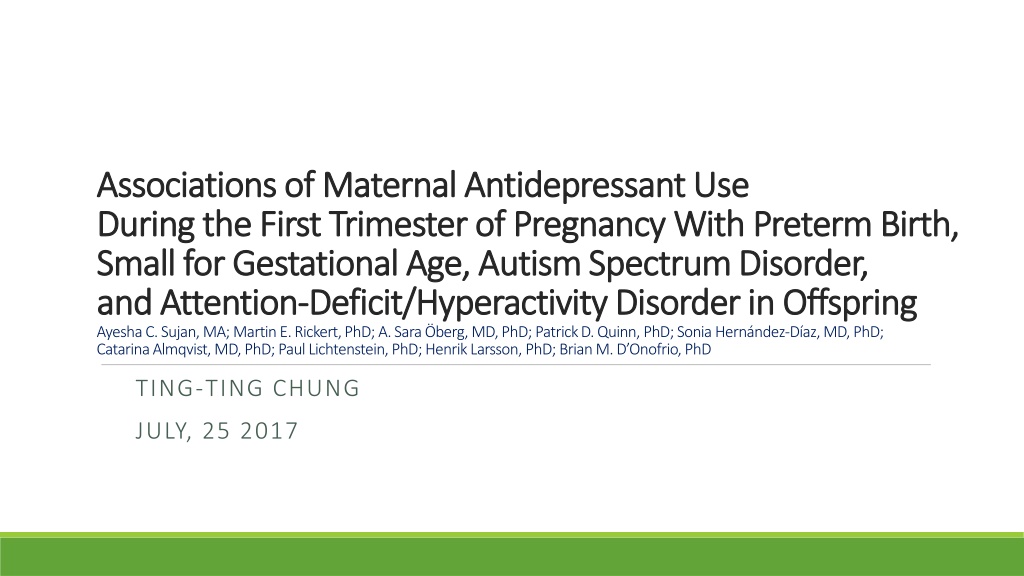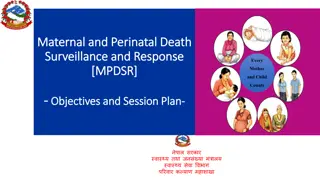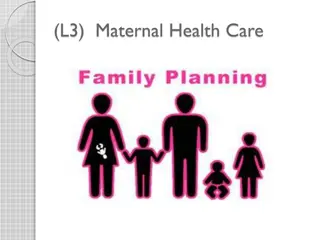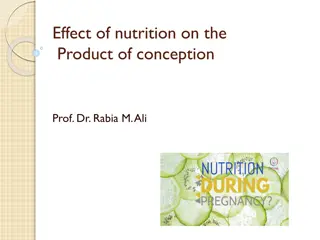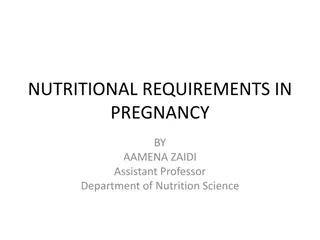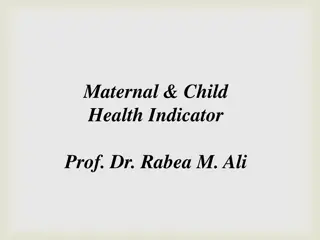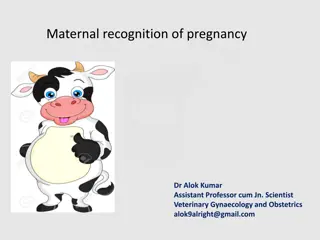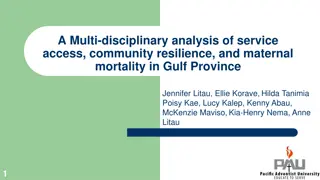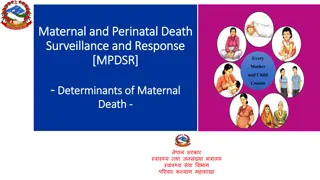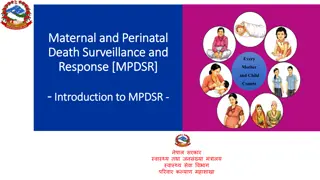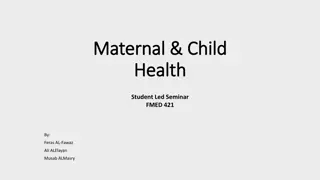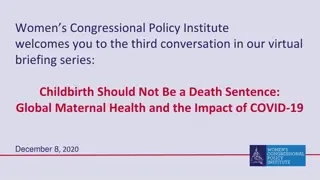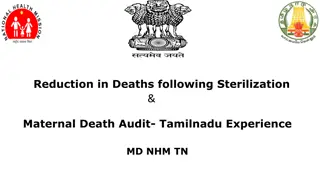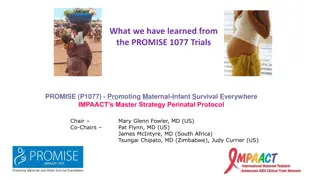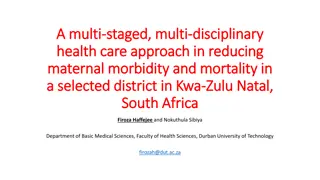Associations of Maternal Antidepressant Use During Pregnancy with Offspring Outcomes
Prenatal antidepressant exposure during the first trimester of pregnancy is linked to various adverse outcomes in offspring, including preterm birth, small for gestational age, autism spectrum disorder, and attention-deficit/hyperactivity disorder. This study evaluates the associations and alternative hypotheses regarding the impact of maternal antidepressant use on birth and neurodevelopmental problems, utilizing data from maternal self-reports, medical registers, and prescribed drug records between 1996 and 2012.
Download Presentation

Please find below an Image/Link to download the presentation.
The content on the website is provided AS IS for your information and personal use only. It may not be sold, licensed, or shared on other websites without obtaining consent from the author. Download presentation by click this link. If you encounter any issues during the download, it is possible that the publisher has removed the file from their server.
E N D
Presentation Transcript
Associations of Maternal Antidepressant Use Associations of Maternal Antidepressant Use During the First Trimester of Pregnancy With Preterm Birth, During the First Trimester of Pregnancy With Preterm Birth, Small for Gestational Age, Autism Spectrum Disorder, Small for Gestational Age, Autism Spectrum Disorder, and Attention and Attention- -Deficit/Hyperactivity Disorder in Offspring Deficit/Hyperactivity Disorder in Offspring Ayesha C. Sujan, MA; Martin E. Rickert, PhD; A. Sara berg, MD, PhD; Patrick D. Quinn, PhD; Sonia Hern ndez-D az, MD, PhD; Catarina Almqvist, MD, PhD; Paul Lichtenstein, PhD; Henrik Larsson, PhD; Brian M. D Onofrio, PhD TING-TING CHUNG JULY, 25 2017
IMPORTANCE IMPORTANCE Prenatal antidepressant exposure has been associated with adverse outcomes Autism spectrum disorder and attention-deficit/ hyperactivity disorder have strong genetic influences, and these influences partially overlap with genetic contributions to depression Randomized clinical trials have not been able to test the safety of antidepressant use during pregnancy because pregnant women are typically excluded from these studies
OBJECTIVE OBJECTIVE To evaluate alternative hypotheses for associations between first- trimester antidepressant exposure and birth and neurodevelopmental problems
Methods Methods- -Antidepressant Exposure Antidepressant Exposure Exposure: Maternal self-reports : Medical Birth Register (between 1996 and 2012) Dispensation records : Prescribed Drug Register (between 2006 and 2012) First-trimester exposure Having at least 1 dispensation between 90 days before estimated conception and 90 days after estimated conception
Methods Methods- -Main Outcomes Main Outcomes Preterm birth: <37 gestational weeks Small for gestational age: birth weight <2 SDs below the mean for gestational age Autism spectrum disorder: International Classification of Diseases, Ninth Revision (ICD-9) and ICD-10 criteria Attention-deficit/hyperactivity disorder: International Classification of Diseases, Ninth Revision (ICD-9) and ICD-10 criteria
Methods Methods- -Covariates Covariates Parity (categorized as first, second, third, or fourth or higher) Year of birth Maternal and paternal covariates country of birth (Sweden or outside of Sweden) age at childbearing (categorized into 6 levels) highest level of completed education (categorized into 7 levels) history of any criminal conviction history of severe psychiatric illnesses (inpatient diagnosis of ICD-8, ICD-9, or ICD-10 schizophrenia, bipolar disorder, or other non-drug-induced psychoses) history of any suicide attempts (definite or uncertain)
Methods Methods- -Statistical Analyses Statistical Analyses Population-Wide Associations and Within-Family Comparisons Logistic regression was used to estimate the model-based associations for the 2 birth outcomes Cox proportional hazards regression (using calendar age in years as the timescale) was used to estimate the associations for the 2 neurodevelopmental outcomes to account for censored observations in the data
Methods Methods- -Statistical Analyses Statistical Analyses Baseline models assessed population-wide associations while only adjusting for pregnancy covariates (parity and year of birth) Population-wide associations were further adjusted for all maternal and paternal covariates Sibling comparison models compared exposure and outcome-discordant offspring within families and included covariates that could vary among siblings born to the same mother
Methods Methods- -Statistical Analyses Statistical Analyses Fixed-effects models were fit using conditional logistic and stratified Cox regression to make purely within-family comparisons These models accounted for all factors that made siblings similar (eg, shared genetic and early environmental influences), as well as measured covariates that vary within families (eg, parity and maternal and paternal age at childbearing), thereby producing a stronger test of the associations than the adjusted population models
Methods Methods- -Comparisons of Timing of Comparisons of Timing of Maternal Use and Paternal Use Maternal Use and Paternal Use To explore whether intrauterine exposure was specifically associated with outcomes over and above maternal depression treatment around the time of pregnancy, associations for maternal first- trimester antidepressant dispensations were compared with associations for dispensations before pregnancy, while adjusting for measured pregnancy covariates, maternal covariates, and paternal covariates
Methods Methods- -Statistical Analyses Statistical Analyses Paternal first-trimester antidepressant dispensations were used as a negative control to further explore the role of familial confounding
Methods Methods- -Sensitivity Analyses Sensitivity Analyses To evaluate the influence of exposure misclassification: 2006 and 2012 This cohort was used because information on exposure based on both maternal self- reports and maternal dispensations were available First-trimester exposure defined as use according to either self-reports or dispensation records First trimester exposure defined as use according to self-reports and also to dispensation records A narrower first-trimester dispensation window of 30days before conception to 90 days after conception At least 2 dispensations during the original first-trimester exposure window
Methods Methods- -Sensitivity Analyses Sensitivity Analyses Given that single-offspring families cannot contribute to sibling- comparison analyses, the population models in the subsample of offspring with siblings were reassessed to evaluate the generalizability of sibling-comparison results To assess whether exposure to other psychotropic medications confounded the associations, the analyses were restricted to offspring not exposed to other psychotropic medications
Results Results 1 670 237 offspring born between 1996 and 2012 Exclude multiple births (48 979 offspring) missing father identifier (16 295) missing or invalid responses on covariates (20 118) missing the small for gestational age variable (4216) 1 580 629 offspring 943 776 distinct mothers and 946 579 distinct fathers
Results Results The timing of exposure and paternal comparisons were conducted on the subsample of 708 450 offspring (born between 2006-2012) 26 477 (3.7%) offspring with first-trimester maternal antidepressant dispensations 18 727 (2.6%) offspring who had fathers with first-trimester antidepressant dispensations
220 (95% CI, 187-254) additional preterm birth cases per 10 000 offspring 35 additional cases per 10 000 offspring [95% CI, 14-56])
Discussion Discussion Maternal antidepressant use during the first trimester of pregnancy was associated with a small increased risk of preterm birth but no increased risk of small for gestational age, autism spectrum disorder, or attention-deficit/hyperactivity disorder
Discussion Discussion Paternal first-trimester antidepressant dispensations were also associated with both neurodevelopmental disorders Because paternal antidepressant use during the first trimester is unlikely to contribute to intrauterine exposure, these findings provide further support that associations between first-trimester antidepressant exposure and offspring neurodevelopmental disorders may be explained by familial confounding
Discussion Discussion Strengths Large, population-based sample First-trimester antidepressant use was indexed by maternal self-report and dispensations The study included 4 outcomes 2 pregnancy-related and 2 neurodevelopmental problems Sensitivity analyses suggested that misclassification of antidepressant use were unlikely to influence the overall conclusions
Discussion Discussion Limitations Observational designs such as these cannot fully rule out all sources of confounding The within-family associations with preterm birth may plausibly be driven by unmeasured time-varying maternal depression rather than by antidepressant use Study focused on first-trimester exposure Vast majority of antidepressant exposure was to SSRIs. Future research should explore class- and drug-specific association Sibling comparisons require large samples to have adequate statistical power
